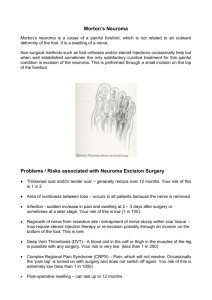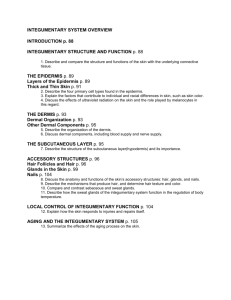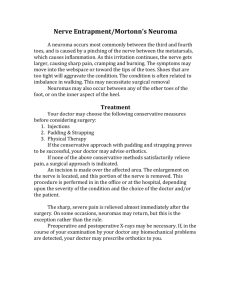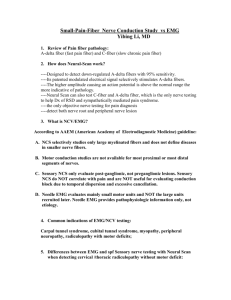Decompression Technique for Morton's Neuroma
advertisement
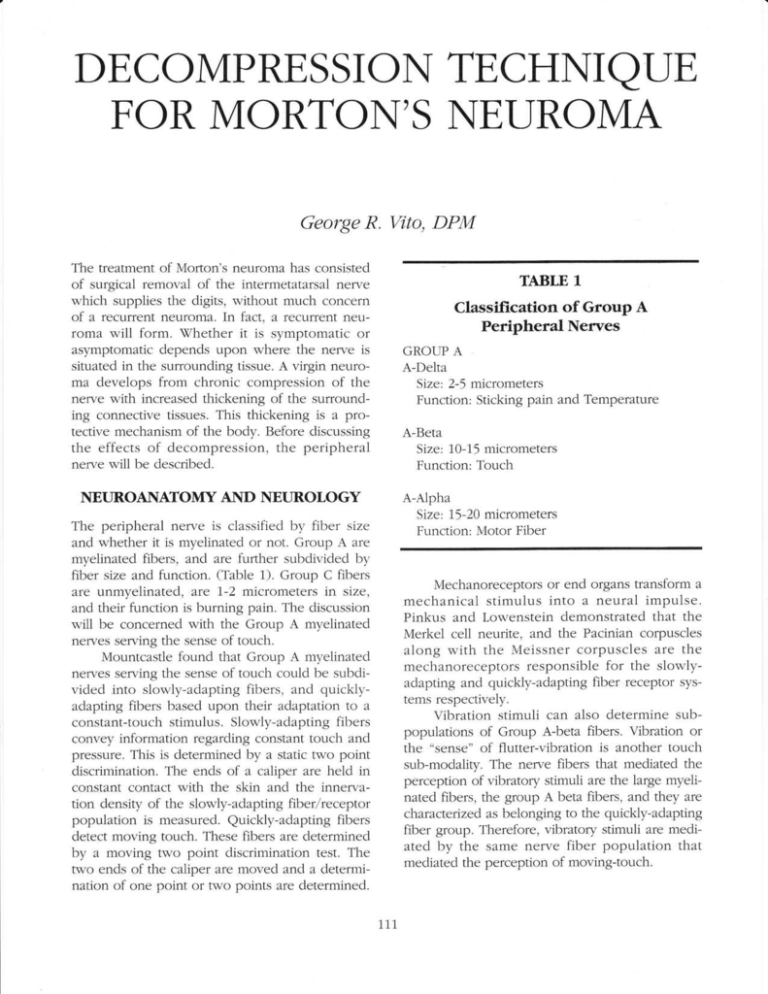
DECOMPRESSION TECHNIQTJE FOR MORTON'S NET]ROMA George R. Vito, DPM The treatment of Mofion's neuroma has consisted of surgical removal of the intermetatarsal nerwe which supplies the digits, without much concef,n of a recurrent neuroma. In fact, a recurfent neuroma will form. \ffrhether it is symptomatic or asymptomatic depends upon where the nerve is situated in the surrounding tissue. A virgin neuroma develops from chronic compression of the nerve with increased thickening of the surrounding connective tissues. This thickening is a protective mechanism of the body. Before discussing TABLE 1 Classifi"cation of Group A Peripheral Nerves GROUP A A-Delta Size: 2-5 micrometers Function: Sticking pain and Tempefature A-Beta Size: 10-15 micrometers the effects of decompression, the peripheral nelve will be described. Function: Touch NEUROANATOMY AND NEUROLOGY A-Alpha Size: 75-20 micrometers Function: Motor Fiber The peripheral nerwe is classified by fiber size and whether it is myelinated or not. Group A are myelinated fibers, and are further subdivided by fiber size and function. (Table 1). Group C fibers are Llnmyelinated, are 7-2 micrometers in size, and their function is burning pain. The discussion will be concerned with the Group A myeiinated nefl/es serwing the sense of touch. Mountcastle found that Group A myelinated nerves sewing the sense of touch could be subdivided into slowly-adapting fibers, and quicklyadapting fibers based upon their adaptation to a constant-touch stimulus. Slowly-adapting fibers convey information regarding constant touch and pressure. This is determined by a static two point discrimination. The ends of a caliper are heid in constant contact with the skin and the innerwation density of the slowly-adapting fiber/receptor population is measured. Quickly-adapting fibers detect moving touch. These fibers are determined by a moving two point discrimination test. The two ends of the caliper are moved and a determination of one point or two points are determined. Mechanoreceptors or end organs transform a mechanical stimulus into a neural impulse. Pinkus and Lowenstein demonstrated that the Merkel cell neurite, and the Pacinian corpuscles along with the Meissner corpuscles are the mechanoreceptors responsible for the slowlyadapting and quickly-adapting fiber receptor systems respectively. Vihration stimuli can also determine subpopulations of Group A-beta fibers. Vibration or the "sense" of flutter-vibration is another touch sub-modalig. The nerve fibers that mediated the perception of vibratory stimuli are the large myelinated fibers, the group A beta fibers, and they are charucterized as belonging to the quickly-adapting fiber group. Therefore, vibratory stimuli are mediated by the same nerve fiber population that mediated the perception of moving-touch. 111 The perception of low frequency vibratory stimuli, 30 cycles per second, is mediated by a quickiy-ada pting f Ib erheceptor system, the Me issner corpuscle in glabrous skin, and the hair follicle lanceolated endings in the hairy skin. The perception of high frequency vlbratory stimuli, 256 cycles per second is mediated by a quicklyadapting fiberlreceptor system, the pacinian corpuscle in glabrous skin, and the hair follicle lanceolated endings in the hairy skin. Clinical evaluation of the patient's vibratory perception tests the same pathway of moving touch through the use of a tuning fork. Because a tuning fork stimulus is usually a new experience for the patient, during testing, the patient need only answer whether or not he perceives "something" and compare it to the same test on the to 25 Micrometers (A-Alpha fibers, Motor). However the sensory component of the mked nerve has a very iarge percentage of A-Beta fibers, 15 to 20 micrometers, the "touch fibers". \7hen a local anesthetic is injected around a mixed nelve, it crosses the epineurium via diffu- sion. The thinnest nerves are affected first, which are subserwed by temperature and pain. Therefore the loss of touch, movement and pressure are the last perceptions to be lost. \7hen ischemia of a peripheral nerve is produced, the oxygen tension is reduced in the vessels that supply the nerue. The oxlzgen gradient from inside the vaso nervosum to the axoplasm decreases. The large nerves, with more axoplasm, are affected by the decreased gradient sooner than the thin nerves, whose smaller diameter allows the available oxygen to still supply its needs at a time when the large fibers cease to function. Therefore with ischemia, the first perceptions to be iost are those of the large fibers; touch. Pain perception is iost last. When direct pressure is applied to a nelve, the force applied to the epineurium is distributed throughout the fascicles to the axons. The largest axons will directly press upon the nearest axon. Large axons will abut large axons. Therefore, the first perceptions to be lost are those of the larger nerves; touch. Pain perception will be lost last. Clinical diagnostic testing of a mixed nerve should not be done with a pin or a needle, but with a tuning fork to evaluate the perception of touch. Vhen the peripheral nerwe is compressed, as in Morton's neuroma, vibratory perception of the digits in comparison to the ipsilateral digits and that of the contralateral limb are abnormal. Commonly the first alteration of nerve compression is one of hypersensitivity. For example, a patient with a nerve compression of the third intermetatarsal space of short duration may observe that the feeling caused by the tuning fork touching the digit is "more sensitive" or "more electric". It is therefore possible that early in the course of neural ischemia (compression), the state of hyperesthesia is present. The examiner must be aware of this possibility. Long duration opposite extremify. The 30 cycie per second tuning fork is best to evaluate the Meissner afferent, (the quicklyadapting fiber receptor system located in the superficiai dermis). The 255 cycles per second tuning fork is best to evaluate the Pacinian afferents, (the quickly-adapting fiber/receptor system located in the deep dermis and subcutis). Both are needed if the physician is following the recovery of sensation after nerve injury, deciding the appropriated timing and phase of sensory reeducation, and investigating peripheral sensibility. Clinical evaluation of nerwe injury, either nerve compression or nelve division with the use of a 30 cps, 256 cps tuning fork and testing two point and moving two point discrimination can accurately diagnose nerve injury. The standard pin prick test for nelve evaluation only tests the Group A myelinated Delta nerves subserving the stimulus of sticking pain and temperature. This pin prick does not test the Group A Myelinated Beta nerves subserying touch. Therefore when a physician in the emergency room is testing the medial plantar nerye for the function of sensory and uses the pin prick test, and elicits pain, the theory that the sensory nerve is intact is wrong. \7hat is intact is the Group A myelinated Deita nelve subserving sticking pain and temperature, not the Group A myelinated Beta nerves subserving sensory. This theory is most important when evaluating the nerve compression syndromes. The peripheral nerve is a mixed nerve having fibers varying in size from 1 to 2 Micrometers (C-fibers) compression of the intermetatarsal nerve will result in the classical description of decreased sensory input. 772 evaluation of the condition, but also in the postoperative analysis of this new surgical approach to an old problem. The question arises when a physician is presented with a nerve compression syndrome in the foot or leg, whether the first surgical consideration should be removal of the nerve. The suggestion of initial decompression of the nerwe with possible relocation of the nelve to alleviate compression should be considered. Bibliography Dellon AL: Eualuation of Sensibility and Re-Education of Sensation in the Hand. Baltimore, John D. Lucas Printing pp. 27-45, 1979. Dellon AL, Mackinnon SE, Crosby PM: Reliability of rwo Point discrimination measurements. J Hand Surg. 12:693-595, L987. Dykes R\7, Terzis JK: Reinnervation of Glabrous skin in Baboons: The complications of recurrent intermetatarsal neuroma can be severe and extremely disabling. In light of the potential for significant complication, primary resection of Mofion's neuroma is a method of treatment which deserves a degree of re-examination. Decompression and relocation of the digital nerve is an alternative that deserves investigational attention. A thorough working knowledge of nerve pathology and function is essential not only in the preoperative Properties of cutaneous mechanoreceptors subsequent to nelwe crush. J Neurophysiol 42:1.161-1178, 1979. Koneitzny F, Hensel H: Response of rapidly and s1ow1y adapting mechanoreceptors and vibratory sensitivity in human skin. PJluegen Arch 358:39-44, 1977. Poppen NK, McCaroll HR Jr, Doyle JR, et al.: Recovery of sensibility after suture of digital oewes. J Hand Surg 4:21.2-226, 1979. Seddon HG: Surgical Disorders of the Peripberal Nerues. Baltimore, '!(iilliams & $7i11iams, p 43, 1972. 173


